Analysis of Management Accounting Systems & Techniques for Agmet Plc
VerifiedAdded on 2020/10/22
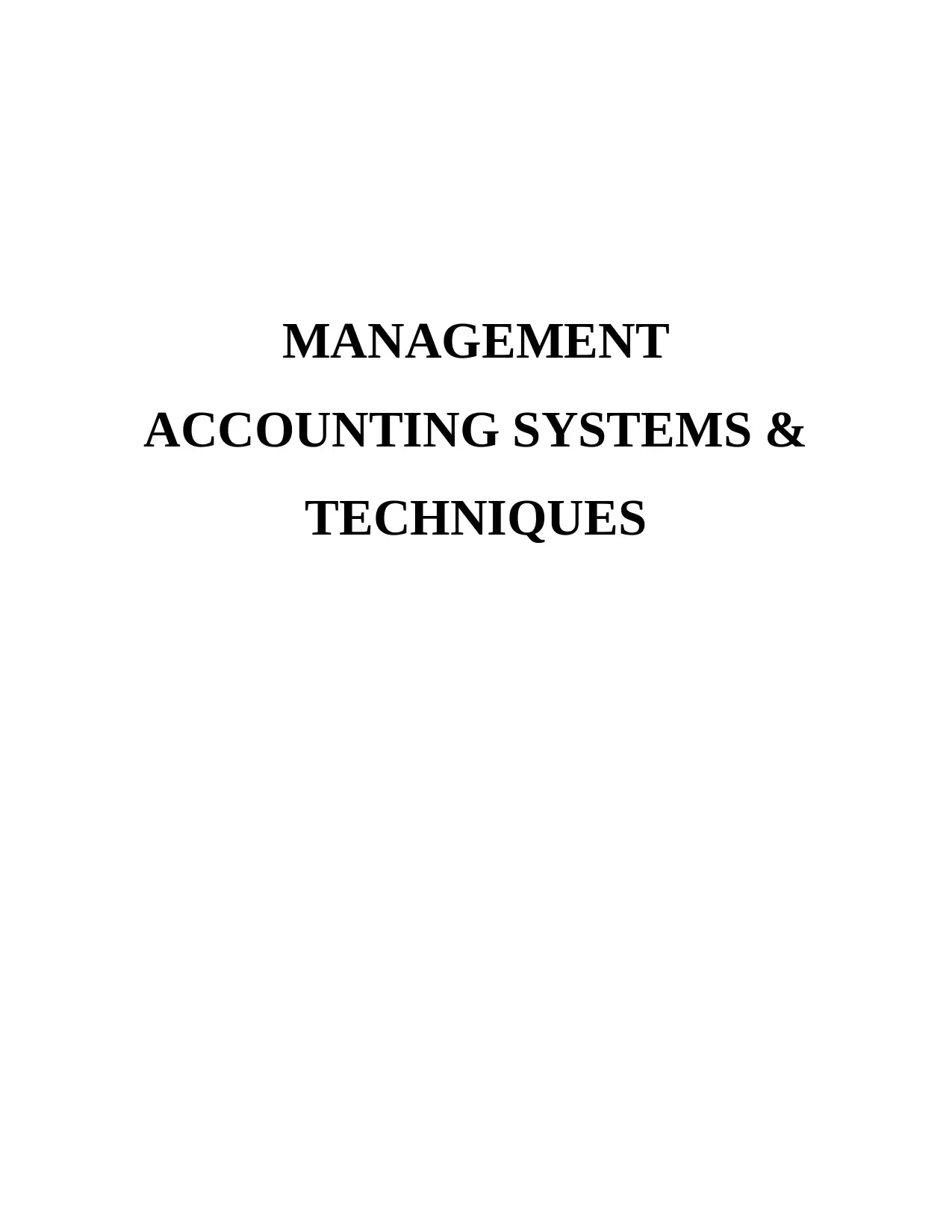
ACCOUNTING SYSTEMS &
TECHNIQUES
Paraphrase This Document

INTRODUCTION ..........................................................................................................................1
TASK 1............................................................................................................................................1
A. Management accounting and essential requirement of different types of accounting...........1
B. Explaining management accounting reports and importance of reports to management.......2
C. Benefits of management accounting systems.........................................................................3
Integrated management accounting system................................................................................4
TASK 2............................................................................................................................................5
A.1) Explanation of absorption and marginal costing method...................................................5
A.2) Preparing Income Statement by considering absorption and marginal costing..................5
B. Calculation of breakeven point and Margin of safety............................................................8
Difference between marginal and absorption costing.................................................................8
C. Applying range of management techniques with its significance..........................................9
D. Producing financial reports with appropriate interpretation..................................................9
TASK 3..........................................................................................................................................10
A. Merits and demerits of various types of planning tools for budgetary control....................10
B. Application of planning tools for the purpose for analysing and forecasting budget..........11
C. Providing comparison for adapting management accounting system for responding
financial problems.....................................................................................................................13
D. Analysing management accounting techniques which are used for responding financial
problems....................................................................................................................................14
E. Evaluating planning tools for solving financial problems which leads to sustainable success
...................................................................................................................................................15
CONCLUSION..............................................................................................................................16
REFERENCES..............................................................................................................................17
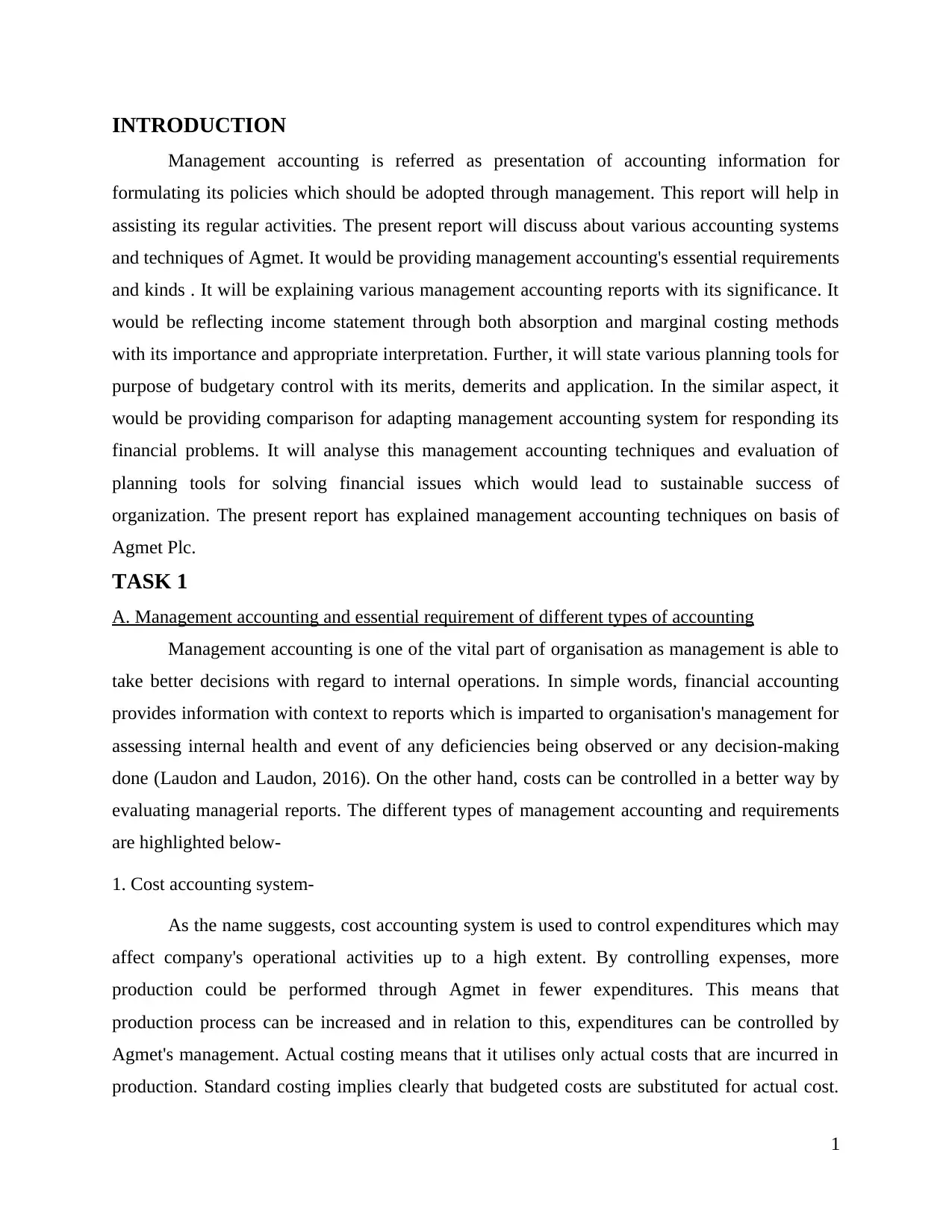
Management accounting is referred as presentation of accounting information for
formulating its policies which should be adopted through management. This report will help in
assisting its regular activities. The present report will discuss about various accounting systems
and techniques of Agmet. It would be providing management accounting's essential requirements
and kinds . It will be explaining various management accounting reports with its significance. It
would be reflecting income statement through both absorption and marginal costing methods
with its importance and appropriate interpretation. Further, it will state various planning tools for
purpose of budgetary control with its merits, demerits and application. In the similar aspect, it
would be providing comparison for adapting management accounting system for responding its
financial problems. It will analyse this management accounting techniques and evaluation of
planning tools for solving financial issues which would lead to sustainable success of
organization. The present report has explained management accounting techniques on basis of
Agmet Plc.
TASK 1
A. Management accounting and essential requirement of different types of accounting
Management accounting is one of the vital part of organisation as management is able to
take better decisions with regard to internal operations. In simple words, financial accounting
provides information with context to reports which is imparted to organisation's management for
assessing internal health and event of any deficiencies being observed or any decision-making
done (Laudon and Laudon, 2016). On the other hand, costs can be controlled in a better way by
evaluating managerial reports. The different types of management accounting and requirements
are highlighted below-
1. Cost accounting system-
As the name suggests, cost accounting system is used to control expenditures which may
affect company's operational activities up to a high extent. By controlling expenses, more
production could be performed through Agmet in fewer expenditures. This means that
production process can be increased and in relation to this, expenditures can be controlled by
Agmet's management. Actual costing means that it utilises only actual costs that are incurred in
production. Standard costing implies clearly that budgeted costs are substituted for actual cost.
1
⊘ This is a preview!⊘
Do you want full access?
Subscribe today to unlock all pages.

Trusted by 1+ million students worldwide
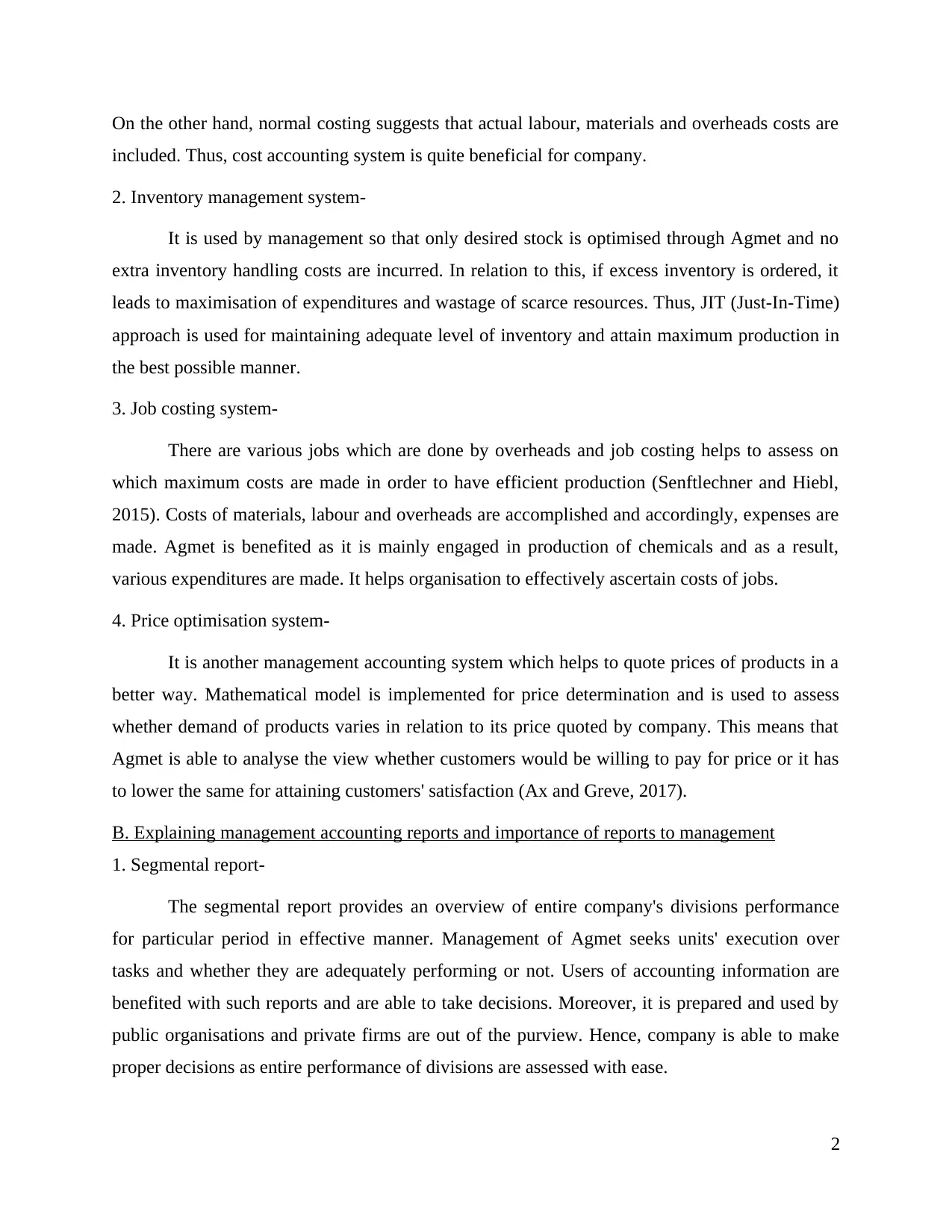
included. Thus, cost accounting system is quite beneficial for company.
2. Inventory management system-
It is used by management so that only desired stock is optimised through Agmet and no
extra inventory handling costs are incurred. In relation to this, if excess inventory is ordered, it
leads to maximisation of expenditures and wastage of scarce resources. Thus, JIT (Just-In-Time)
approach is used for maintaining adequate level of inventory and attain maximum production in
the best possible manner.
3. Job costing system-
There are various jobs which are done by overheads and job costing helps to assess on
which maximum costs are made in order to have efficient production (Senftlechner and Hiebl,
2015). Costs of materials, labour and overheads are accomplished and accordingly, expenses are
made. Agmet is benefited as it is mainly engaged in production of chemicals and as a result,
various expenditures are made. It helps organisation to effectively ascertain costs of jobs.
4. Price optimisation system-
It is another management accounting system which helps to quote prices of products in a
better way. Mathematical model is implemented for price determination and is used to assess
whether demand of products varies in relation to its price quoted by company. This means that
Agmet is able to analyse the view whether customers would be willing to pay for price or it has
to lower the same for attaining customers' satisfaction (Ax and Greve, 2017).
B. Explaining management accounting reports and importance of reports to management
1. Segmental report-
The segmental report provides an overview of entire company's divisions performance
for particular period in effective manner. Management of Agmet seeks units' execution over
tasks and whether they are adequately performing or not. Users of accounting information are
benefited with such reports and are able to take decisions. Moreover, it is prepared and used by
public organisations and private firms are out of the purview. Hence, company is able to make
proper decisions as entire performance of divisions are assessed with ease.
2
Paraphrase This Document
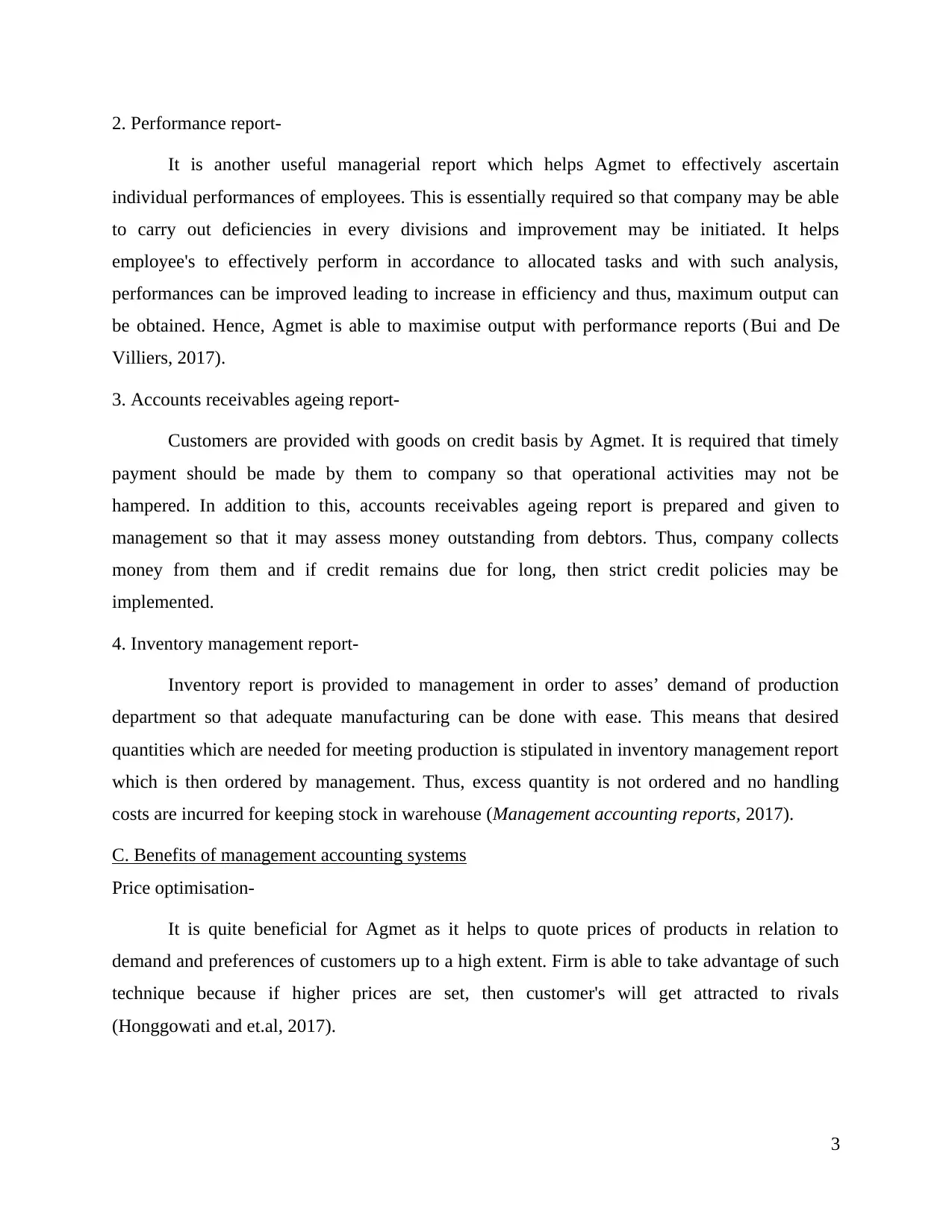
It is another useful managerial report which helps Agmet to effectively ascertain
individual performances of employees. This is essentially required so that company may be able
to carry out deficiencies in every divisions and improvement may be initiated. It helps
employee's to effectively perform in accordance to allocated tasks and with such analysis,
performances can be improved leading to increase in efficiency and thus, maximum output can
be obtained. Hence, Agmet is able to maximise output with performance reports (Bui and De
Villiers, 2017).
3. Accounts receivables ageing report-
Customers are provided with goods on credit basis by Agmet. It is required that timely
payment should be made by them to company so that operational activities may not be
hampered. In addition to this, accounts receivables ageing report is prepared and given to
management so that it may assess money outstanding from debtors. Thus, company collects
money from them and if credit remains due for long, then strict credit policies may be
implemented.
4. Inventory management report-
Inventory report is provided to management in order to asses’ demand of production
department so that adequate manufacturing can be done with ease. This means that desired
quantities which are needed for meeting production is stipulated in inventory management report
which is then ordered by management. Thus, excess quantity is not ordered and no handling
costs are incurred for keeping stock in warehouse (Management accounting reports, 2017).
C. Benefits of management accounting systems
Price optimisation-
It is quite beneficial for Agmet as it helps to quote prices of products in relation to
demand and preferences of customers up to a high extent. Firm is able to take advantage of such
technique because if higher prices are set, then customer's will get attracted to rivals
(Honggowati and et.al, 2017).
3
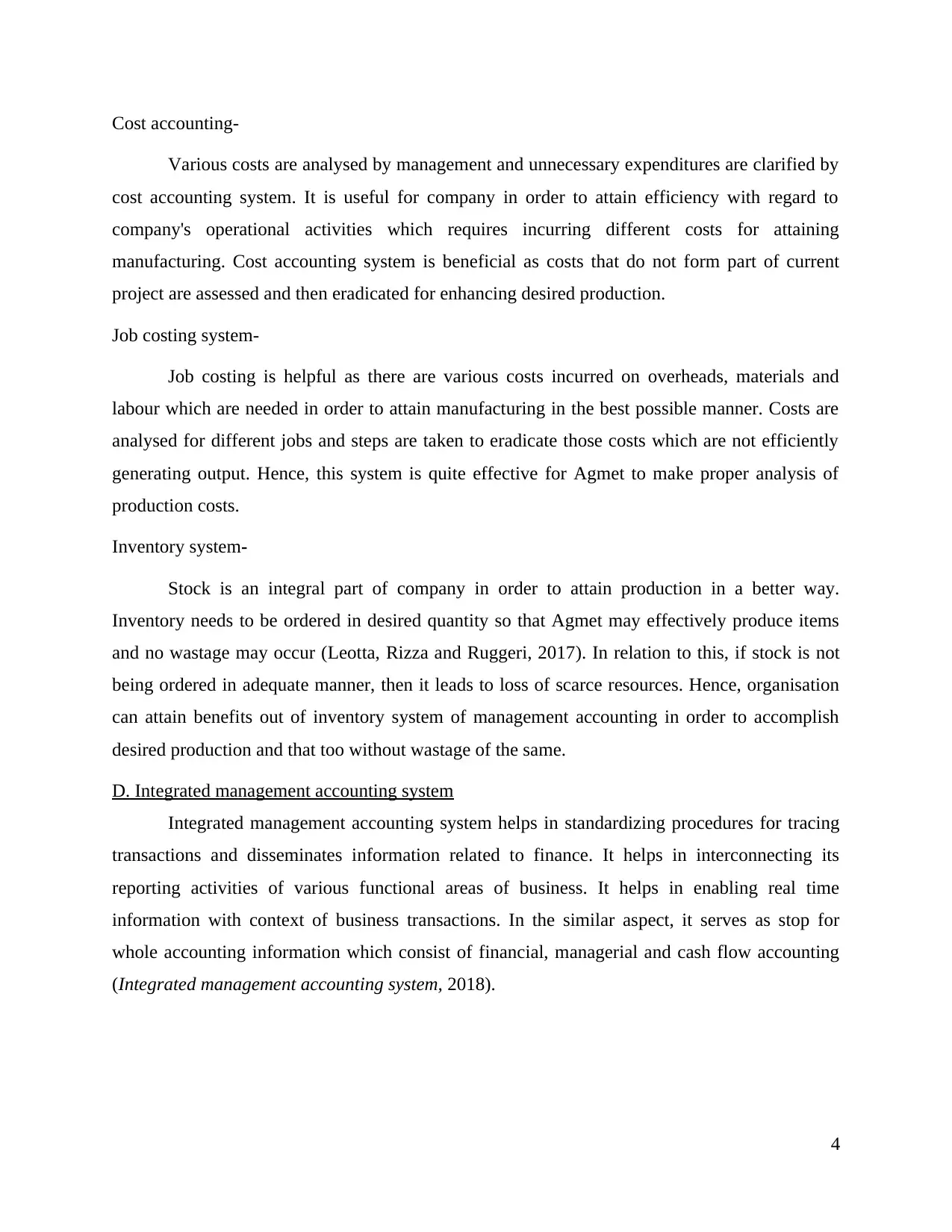
Various costs are analysed by management and unnecessary expenditures are clarified by
cost accounting system. It is useful for company in order to attain efficiency with regard to
company's operational activities which requires incurring different costs for attaining
manufacturing. Cost accounting system is beneficial as costs that do not form part of current
project are assessed and then eradicated for enhancing desired production.
Job costing system-
Job costing is helpful as there are various costs incurred on overheads, materials and
labour which are needed in order to attain manufacturing in the best possible manner. Costs are
analysed for different jobs and steps are taken to eradicate those costs which are not efficiently
generating output. Hence, this system is quite effective for Agmet to make proper analysis of
production costs.
Inventory system-
Stock is an integral part of company in order to attain production in a better way.
Inventory needs to be ordered in desired quantity so that Agmet may effectively produce items
and no wastage may occur (Leotta, Rizza and Ruggeri, 2017). In relation to this, if stock is not
being ordered in adequate manner, then it leads to loss of scarce resources. Hence, organisation
can attain benefits out of inventory system of management accounting in order to accomplish
desired production and that too without wastage of the same.
D. Integrated management accounting system
Integrated management accounting system helps in standardizing procedures for tracing
transactions and disseminates information related to finance. It helps in interconnecting its
reporting activities of various functional areas of business. It helps in enabling real time
information with context of business transactions. In the similar aspect, it serves as stop for
whole accounting information which consist of financial, managerial and cash flow accounting
(Integrated management accounting system, 2018).
4
⊘ This is a preview!⊘
Do you want full access?
Subscribe today to unlock all pages.

Trusted by 1+ million students worldwide
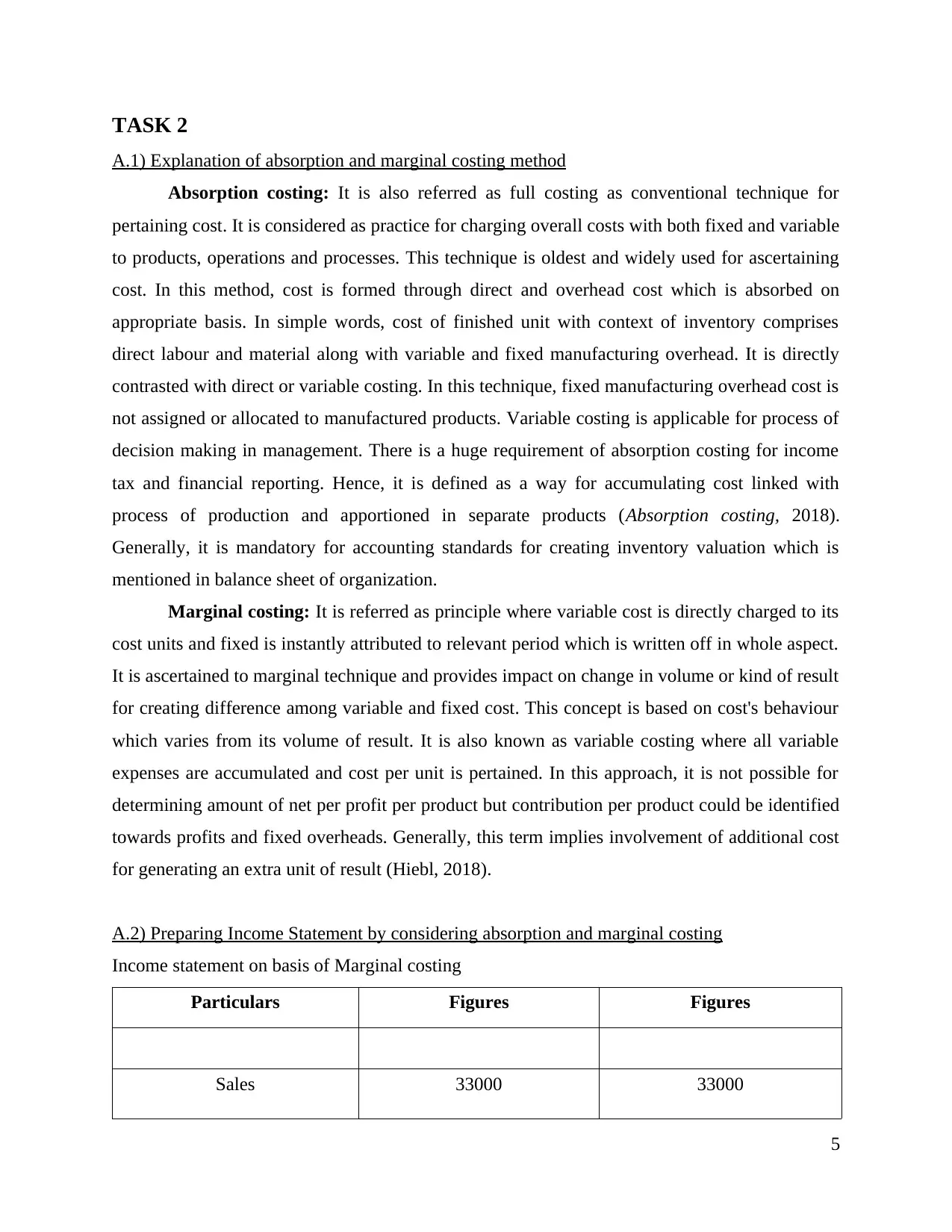
A.1) Explanation of absorption and marginal costing method
Absorption costing: It is also referred as full costing as conventional technique for
pertaining cost. It is considered as practice for charging overall costs with both fixed and variable
to products, operations and processes. This technique is oldest and widely used for ascertaining
cost. In this method, cost is formed through direct and overhead cost which is absorbed on
appropriate basis. In simple words, cost of finished unit with context of inventory comprises
direct labour and material along with variable and fixed manufacturing overhead. It is directly
contrasted with direct or variable costing. In this technique, fixed manufacturing overhead cost is
not assigned or allocated to manufactured products. Variable costing is applicable for process of
decision making in management. There is a huge requirement of absorption costing for income
tax and financial reporting. Hence, it is defined as a way for accumulating cost linked with
process of production and apportioned in separate products (Absorption costing, 2018).
Generally, it is mandatory for accounting standards for creating inventory valuation which is
mentioned in balance sheet of organization.
Marginal costing: It is referred as principle where variable cost is directly charged to its
cost units and fixed is instantly attributed to relevant period which is written off in whole aspect.
It is ascertained to marginal technique and provides impact on change in volume or kind of result
for creating difference among variable and fixed cost. This concept is based on cost's behaviour
which varies from its volume of result. It is also known as variable costing where all variable
expenses are accumulated and cost per unit is pertained. In this approach, it is not possible for
determining amount of net per profit per product but contribution per product could be identified
towards profits and fixed overheads. Generally, this term implies involvement of additional cost
for generating an extra unit of result (Hiebl, 2018).
A.2) Preparing Income Statement by considering absorption and marginal costing
Income statement on basis of Marginal costing
Particulars Figures Figures
Sales 33000 33000
5
Paraphrase This Document
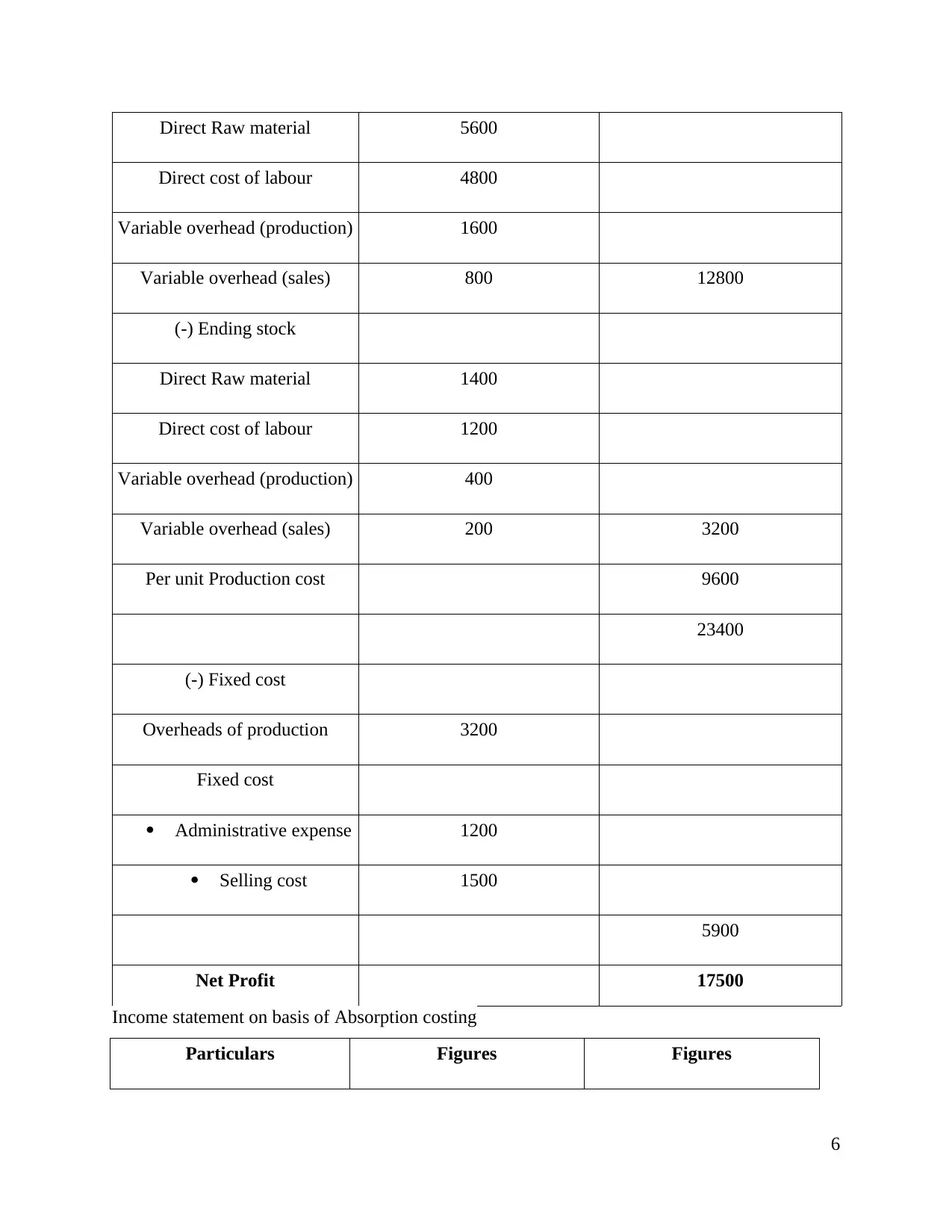
Direct cost of labour 4800
Variable overhead (production) 1600
Variable overhead (sales) 800 12800
(-) Ending stock
Direct Raw material 1400
Direct cost of labour 1200
Variable overhead (production) 400
Variable overhead (sales) 200 3200
Per unit Production cost 9600
23400
(-) Fixed cost
Overheads of production 3200
Fixed cost
Administrative expense 1200
Selling cost 1500
5900
Net Profit 17500
Income statement on basis of Absorption costing
Particulars Figures Figures
6
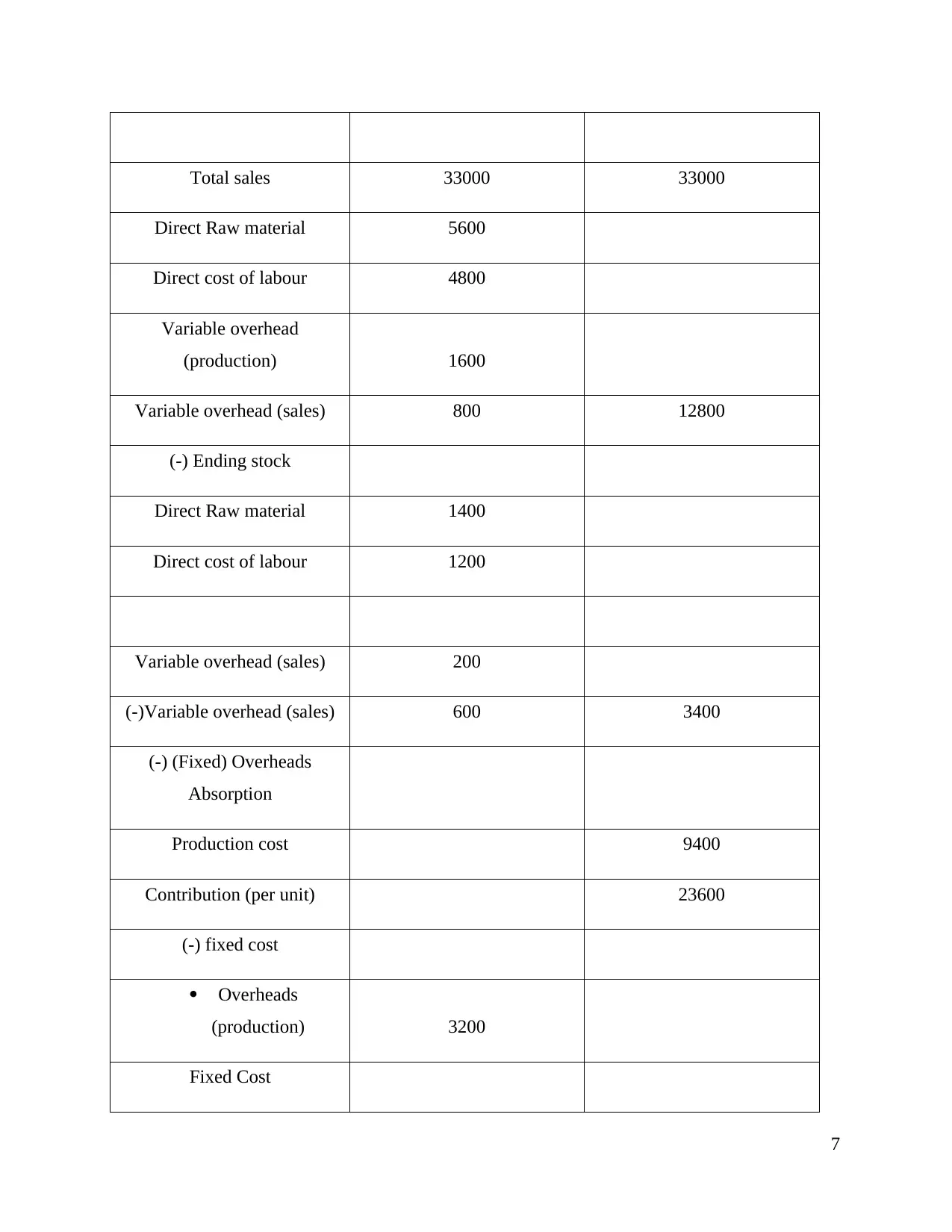
Direct Raw material 5600
Direct cost of labour 4800
Variable overhead
(production) 1600
Variable overhead (sales) 800 12800
(-) Ending stock
Direct Raw material 1400
Direct cost of labour 1200
Variable overhead (sales) 200
(-)Variable overhead (sales) 600 3400
(-) (Fixed) Overheads
Absorption
Production cost 9400
Contribution (per unit) 23600
(-) fixed cost
Overheads
(production) 3200
Fixed Cost
7
⊘ This is a preview!⊘
Do you want full access?
Subscribe today to unlock all pages.

Trusted by 1+ million students worldwide
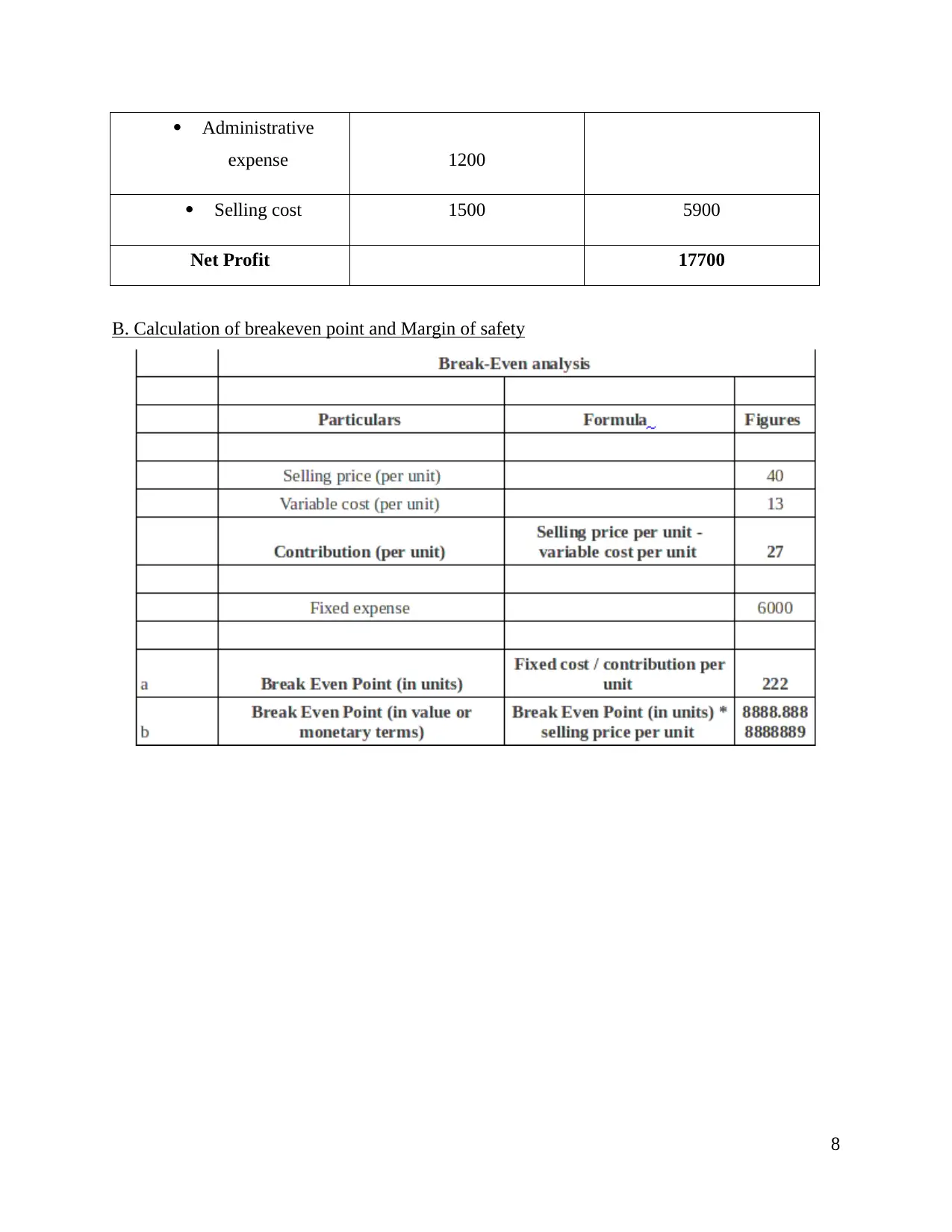
expense 1200
Selling cost 1500 5900
Net Profit 17700
B. Calculation of breakeven point and Margin of safety
8
Paraphrase This Document
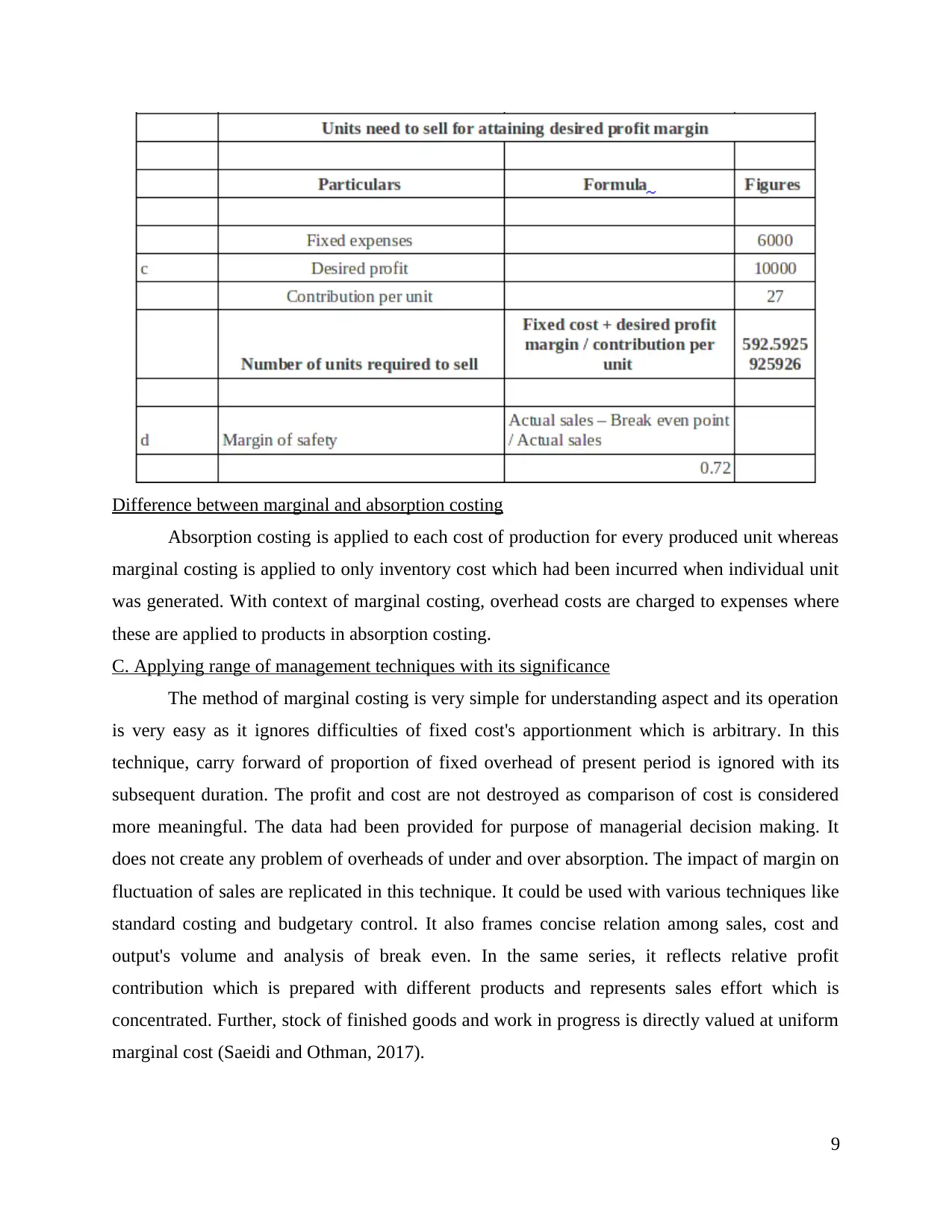
Absorption costing is applied to each cost of production for every produced unit whereas
marginal costing is applied to only inventory cost which had been incurred when individual unit
was generated. With context of marginal costing, overhead costs are charged to expenses where
these are applied to products in absorption costing.
C. Applying range of management techniques with its significance
The method of marginal costing is very simple for understanding aspect and its operation
is very easy as it ignores difficulties of fixed cost's apportionment which is arbitrary. In this
technique, carry forward of proportion of fixed overhead of present period is ignored with its
subsequent duration. The profit and cost are not destroyed as comparison of cost is considered
more meaningful. The data had been provided for purpose of managerial decision making. It
does not create any problem of overheads of under and over absorption. The impact of margin on
fluctuation of sales are replicated in this technique. It could be used with various techniques like
standard costing and budgetary control. It also frames concise relation among sales, cost and
output's volume and analysis of break even. In the same series, it reflects relative profit
contribution which is prepared with different products and represents sales effort which is
concentrated. Further, stock of finished goods and work in progress is directly valued at uniform
marginal cost (Saeidi and Othman, 2017).
9
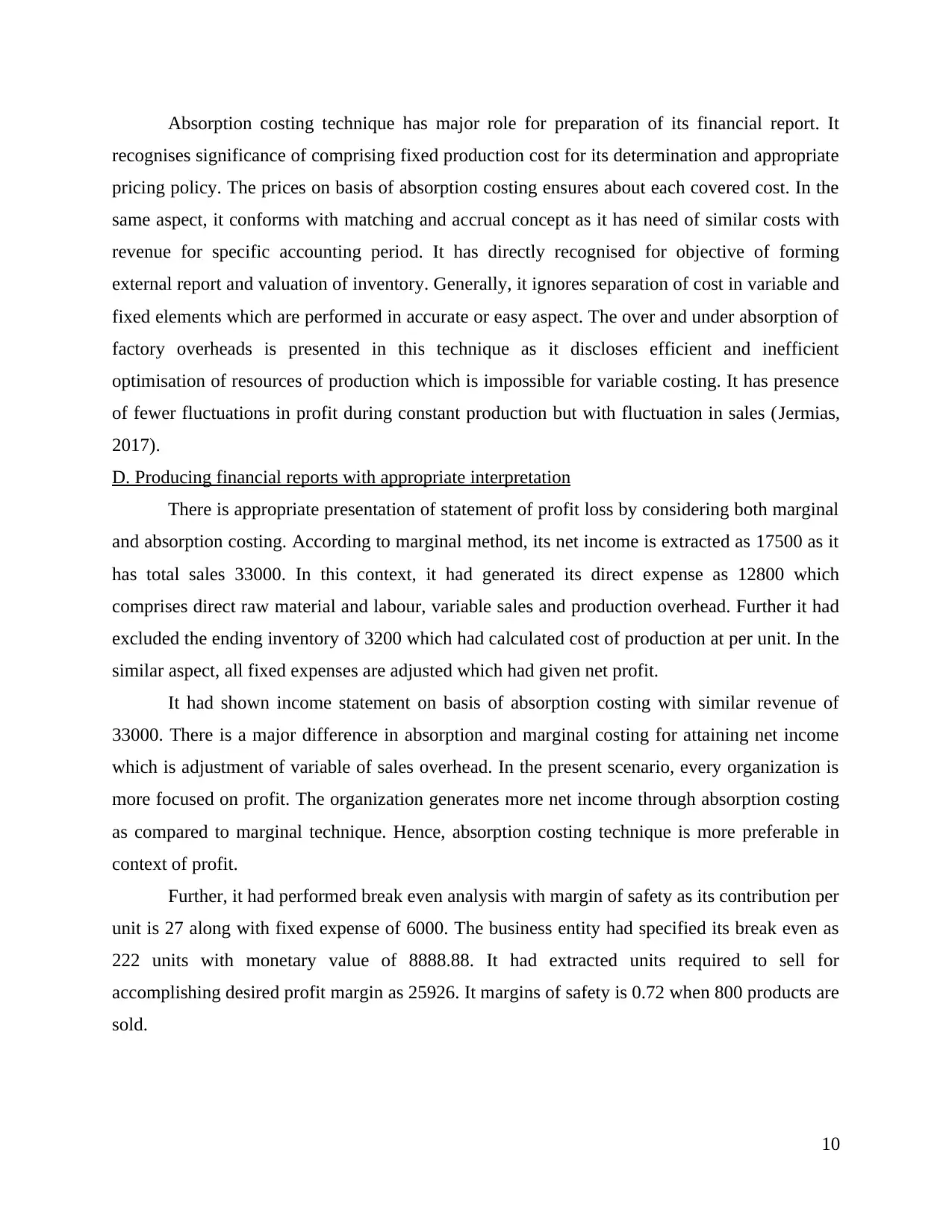
recognises significance of comprising fixed production cost for its determination and appropriate
pricing policy. The prices on basis of absorption costing ensures about each covered cost. In the
same aspect, it conforms with matching and accrual concept as it has need of similar costs with
revenue for specific accounting period. It has directly recognised for objective of forming
external report and valuation of inventory. Generally, it ignores separation of cost in variable and
fixed elements which are performed in accurate or easy aspect. The over and under absorption of
factory overheads is presented in this technique as it discloses efficient and inefficient
optimisation of resources of production which is impossible for variable costing. It has presence
of fewer fluctuations in profit during constant production but with fluctuation in sales (Jermias,
2017).
D. Producing financial reports with appropriate interpretation
There is appropriate presentation of statement of profit loss by considering both marginal
and absorption costing. According to marginal method, its net income is extracted as 17500 as it
has total sales 33000. In this context, it had generated its direct expense as 12800 which
comprises direct raw material and labour, variable sales and production overhead. Further it had
excluded the ending inventory of 3200 which had calculated cost of production at per unit. In the
similar aspect, all fixed expenses are adjusted which had given net profit.
It had shown income statement on basis of absorption costing with similar revenue of
33000. There is a major difference in absorption and marginal costing for attaining net income
which is adjustment of variable of sales overhead. In the present scenario, every organization is
more focused on profit. The organization generates more net income through absorption costing
as compared to marginal technique. Hence, absorption costing technique is more preferable in
context of profit.
Further, it had performed break even analysis with margin of safety as its contribution per
unit is 27 along with fixed expense of 6000. The business entity had specified its break even as
222 units with monetary value of 8888.88. It had extracted units required to sell for
accomplishing desired profit margin as 25926. It margins of safety is 0.72 when 800 products are
sold.
10
⊘ This is a preview!⊘
Do you want full access?
Subscribe today to unlock all pages.

Trusted by 1+ million students worldwide
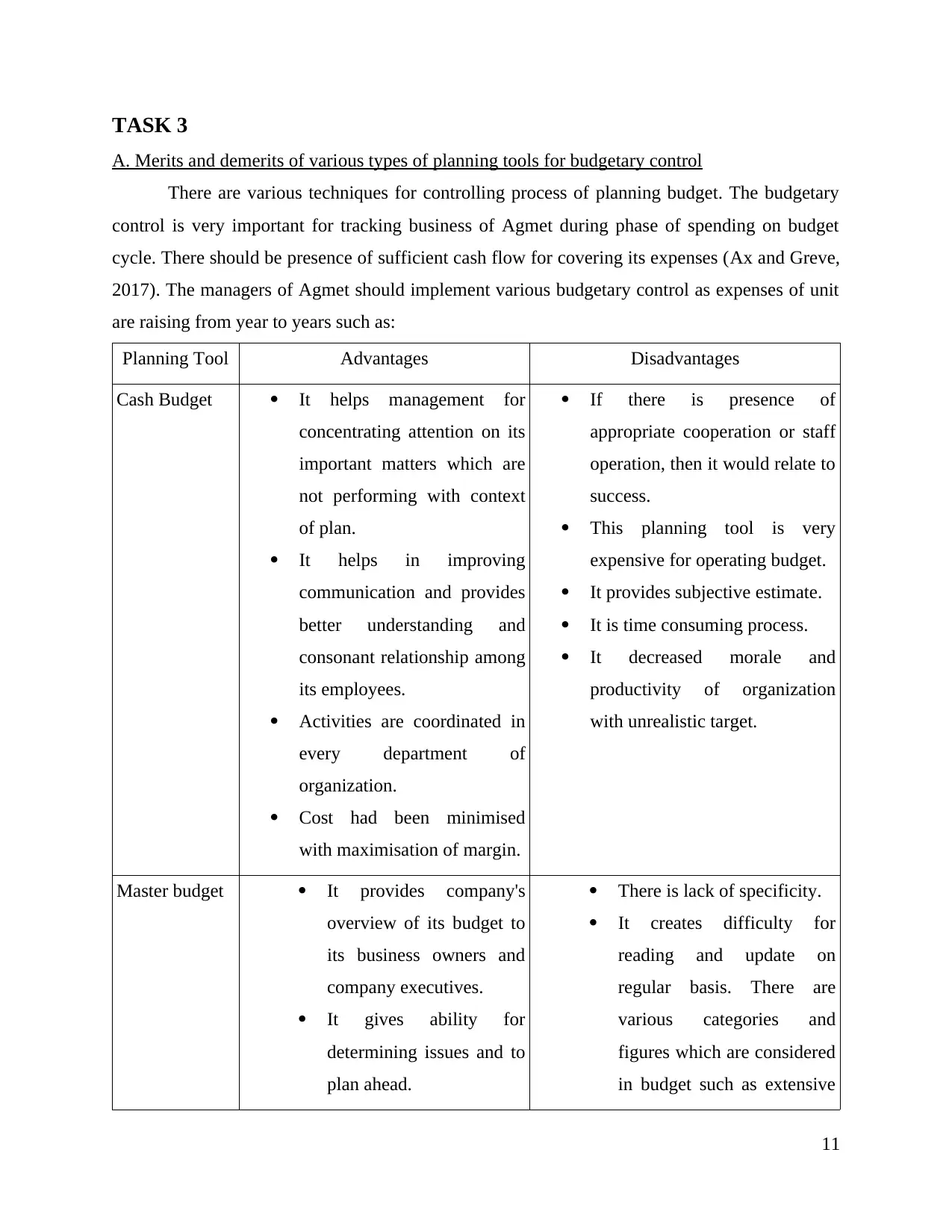
A. Merits and demerits of various types of planning tools for budgetary control
There are various techniques for controlling process of planning budget. The budgetary
control is very important for tracking business of Agmet during phase of spending on budget
cycle. There should be presence of sufficient cash flow for covering its expenses (Ax and Greve,
2017). The managers of Agmet should implement various budgetary control as expenses of unit
are raising from year to years such as:
Planning Tool Advantages Disadvantages
Cash Budget It helps management for
concentrating attention on its
important matters which are
not performing with context
of plan.
It helps in improving
communication and provides
better understanding and
consonant relationship among
its employees.
Activities are coordinated in
every department of
organization.
Cost had been minimised
with maximisation of margin.
If there is presence of
appropriate cooperation or staff
operation, then it would relate to
success.
This planning tool is very
expensive for operating budget.
It provides subjective estimate.
It is time consuming process.
It decreased morale and
productivity of organization
with unrealistic target.
Master budget It provides company's
overview of its budget to
its business owners and
company executives.
It gives ability for
determining issues and to
plan ahead.
There is lack of specificity.
It creates difficulty for
reading and update on
regular basis. There are
various categories and
figures which are considered
in budget such as extensive
11
Paraphrase This Document

revealed with context of
revenue, profit, cash
flows and expenses etc.
It has presence of each
information with context
of projecting balance
sheet.
charts and descriptions.
It is directly based on
various assumptions as it
might not prove correct over
period.
Variance
analysis
It helps in measuring
performance.
It helps in controlling cost
(Zimmerman and Yahya-
Zadeh, 2011).
All inefficient performances
are highlighted with extent of
inefficiency.
It sets wrong standard material.
Usage of wrong standard
material.
Material prices are decreased
because of market forces.
B. Application of planning tools for the purpose for analysing and forecasting budget
Sept Oct Nov Dec Jan
Receipts £ £ £ £ £
Cash sales 80000 75000 65000 60000 65000
Credit sale
receipts from
debtors 53000 42000 10000 17500 12000
Other income
received 8000 7000 5000 4000 4500
Total receipts
(a) 141000 124000 80000 81500 81500
Payments
Purchases 23000 24150 15000 19000 20000
12
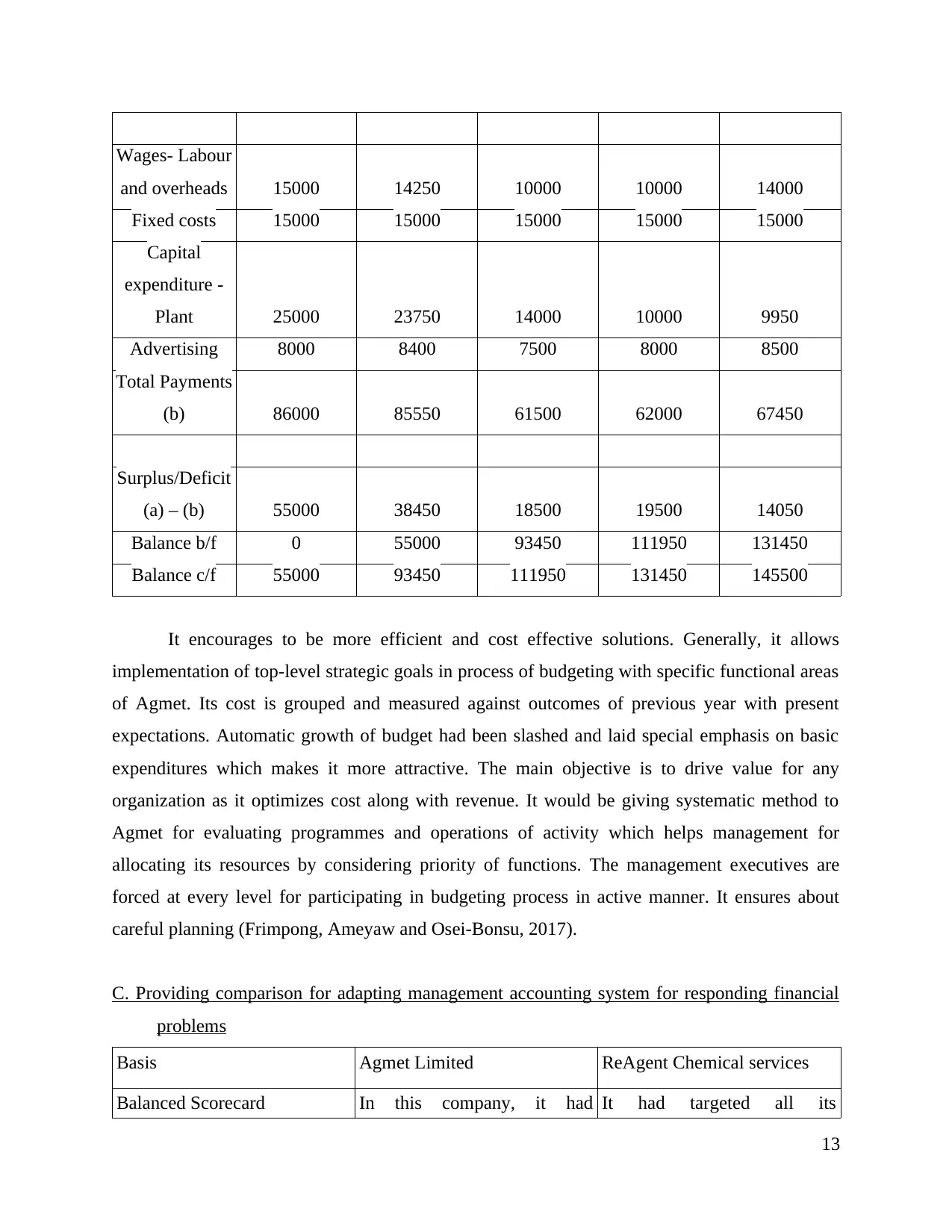
and overheads 15000 14250 10000 10000 14000
Fixed costs 15000 15000 15000 15000 15000
Capital
expenditure -
Plant 25000 23750 14000 10000 9950
Advertising 8000 8400 7500 8000 8500
Total Payments
(b) 86000 85550 61500 62000 67450
Surplus/Deficit
(a) – (b) 55000 38450 18500 19500 14050
Balance b/f 0 55000 93450 111950 131450
Balance c/f 55000 93450 111950 131450 145500
It encourages to be more efficient and cost effective solutions. Generally, it allows
implementation of top-level strategic goals in process of budgeting with specific functional areas
of Agmet. Its cost is grouped and measured against outcomes of previous year with present
expectations. Automatic growth of budget had been slashed and laid special emphasis on basic
expenditures which makes it more attractive. The main objective is to drive value for any
organization as it optimizes cost along with revenue. It would be giving systematic method to
Agmet for evaluating programmes and operations of activity which helps management for
allocating its resources by considering priority of functions. The management executives are
forced at every level for participating in budgeting process in active manner. It ensures about
careful planning (Frimpong, Ameyaw and Osei-Bonsu, 2017).
C. Providing comparison for adapting management accounting system for responding financial
problems
Basis Agmet Limited ReAgent Chemical services
Balanced Scorecard In this company, it had It had targeted all its
13
⊘ This is a preview!⊘
Do you want full access?
Subscribe today to unlock all pages.

Trusted by 1+ million students worldwide
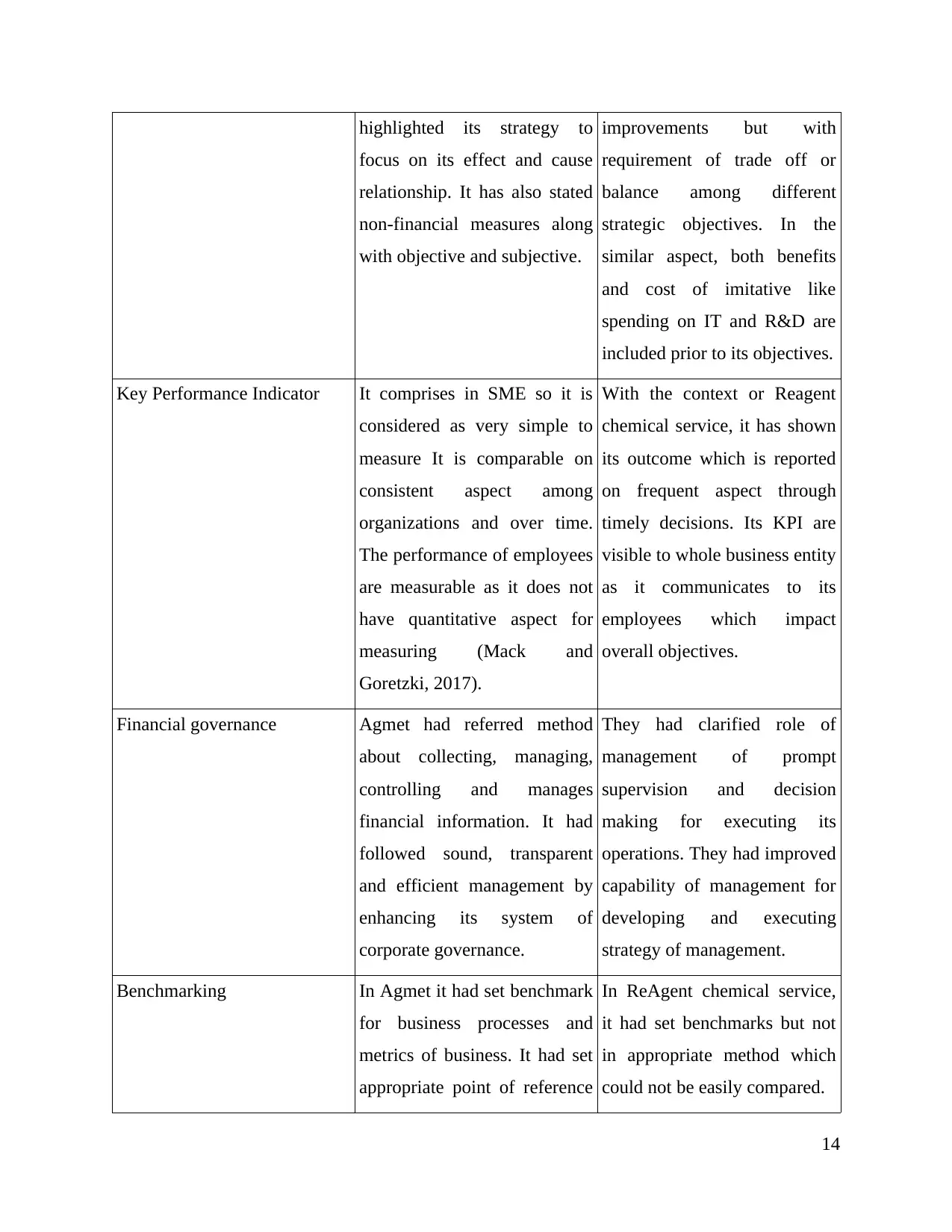
focus on its effect and cause
relationship. It has also stated
non-financial measures along
with objective and subjective.
improvements but with
requirement of trade off or
balance among different
strategic objectives. In the
similar aspect, both benefits
and cost of imitative like
spending on IT and R&D are
included prior to its objectives.
Key Performance Indicator It comprises in SME so it is
considered as very simple to
measure It is comparable on
consistent aspect among
organizations and over time.
The performance of employees
are measurable as it does not
have quantitative aspect for
measuring (Mack and
Goretzki, 2017).
With the context or Reagent
chemical service, it has shown
its outcome which is reported
on frequent aspect through
timely decisions. Its KPI are
visible to whole business entity
as it communicates to its
employees which impact
overall objectives.
Financial governance Agmet had referred method
about collecting, managing,
controlling and manages
financial information. It had
followed sound, transparent
and efficient management by
enhancing its system of
corporate governance.
They had clarified role of
management of prompt
supervision and decision
making for executing its
operations. They had improved
capability of management for
developing and executing
strategy of management.
Benchmarking In Agmet it had set benchmark
for business processes and
metrics of business. It had set
appropriate point of reference
In ReAgent chemical service,
it had set benchmarks but not
in appropriate method which
could not be easily compared.
14
Paraphrase This Document

responsibility towards society
in SME.
D. Analysing management accounting techniques which are used for responding financial
problems
There are various management accounting techniques for solving financial problems as
their main objective is to maximise profit. It could be attained through sound financial planning.
For growth of business, the organization must analysis its important financial statement such as
profit and loss account, balance sheet and statement of change in equity. Cash is considered as
very important element of business, movement of liquid from one to another period could be
extracted along with its operation. In the similar aspect. There is presence of various budgetary
control techniques in which future financial requirements are estimated and controls financial
performances of business concern (Clark, Menifield and Stewart, 2018). In the above scenario,
different planning tools are used for solving financial problems in both organization Agmet
Limited and Reagent chemical services which are analysed below:
Balance Score card: It is considered as major accounting techniques which helps to
respond to its financial problems. It lays special focus on significant strategic issues which helps
organization for monitoring its execution of plan. It helps in providing framework for aligning
from each member of business entity with context of its vision and mission. The business entity
is very responsive to its alteration in competitive landscape. Quantifiable metrics are given which
reflects organization's health in true and fair aspect. Transparency is termed as major advantage
to organization. The projects are associated to its measures and with reference to strategy.
Key Performance indicator: These indicators are skewed towards various financial
measures but non-financial are not significant. It helps in strategic execution as well as to
illustrate management strategy. It assists in measuring goals as they are accomplished through
business or not. It gives information along with feedback which helps in effective decision
making. There are various concerns which might change over time such as people, goals and
priorities but KPI measurements are constant. It is mandatory for strategic goals for long term
perspective.
15
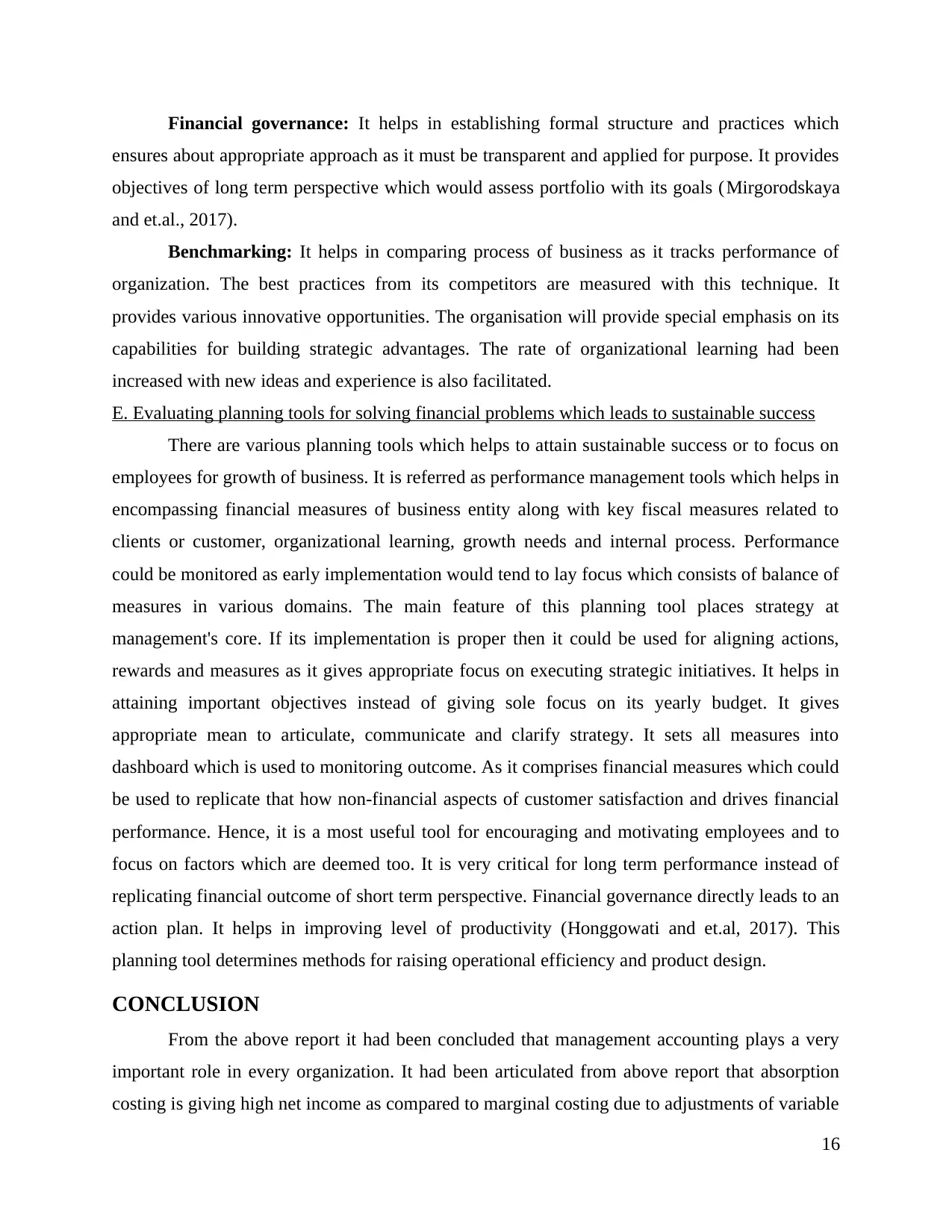
ensures about appropriate approach as it must be transparent and applied for purpose. It provides
objectives of long term perspective which would assess portfolio with its goals (Mirgorodskaya
and et.al., 2017).
Benchmarking: It helps in comparing process of business as it tracks performance of
organization. The best practices from its competitors are measured with this technique. It
provides various innovative opportunities. The organisation will provide special emphasis on its
capabilities for building strategic advantages. The rate of organizational learning had been
increased with new ideas and experience is also facilitated.
E. Evaluating planning tools for solving financial problems which leads to sustainable success
There are various planning tools which helps to attain sustainable success or to focus on
employees for growth of business. It is referred as performance management tools which helps in
encompassing financial measures of business entity along with key fiscal measures related to
clients or customer, organizational learning, growth needs and internal process. Performance
could be monitored as early implementation would tend to lay focus which consists of balance of
measures in various domains. The main feature of this planning tool places strategy at
management's core. If its implementation is proper then it could be used for aligning actions,
rewards and measures as it gives appropriate focus on executing strategic initiatives. It helps in
attaining important objectives instead of giving sole focus on its yearly budget. It gives
appropriate mean to articulate, communicate and clarify strategy. It sets all measures into
dashboard which is used to monitoring outcome. As it comprises financial measures which could
be used to replicate that how non-financial aspects of customer satisfaction and drives financial
performance. Hence, it is a most useful tool for encouraging and motivating employees and to
focus on factors which are deemed too. It is very critical for long term performance instead of
replicating financial outcome of short term perspective. Financial governance directly leads to an
action plan. It helps in improving level of productivity (Honggowati and et.al, 2017). This
planning tool determines methods for raising operational efficiency and product design.
CONCLUSION
From the above report it had been concluded that management accounting plays a very
important role in every organization. It had been articulated from above report that absorption
costing is giving high net income as compared to marginal costing due to adjustments of variable
16
⊘ This is a preview!⊘
Do you want full access?
Subscribe today to unlock all pages.

Trusted by 1+ million students worldwide
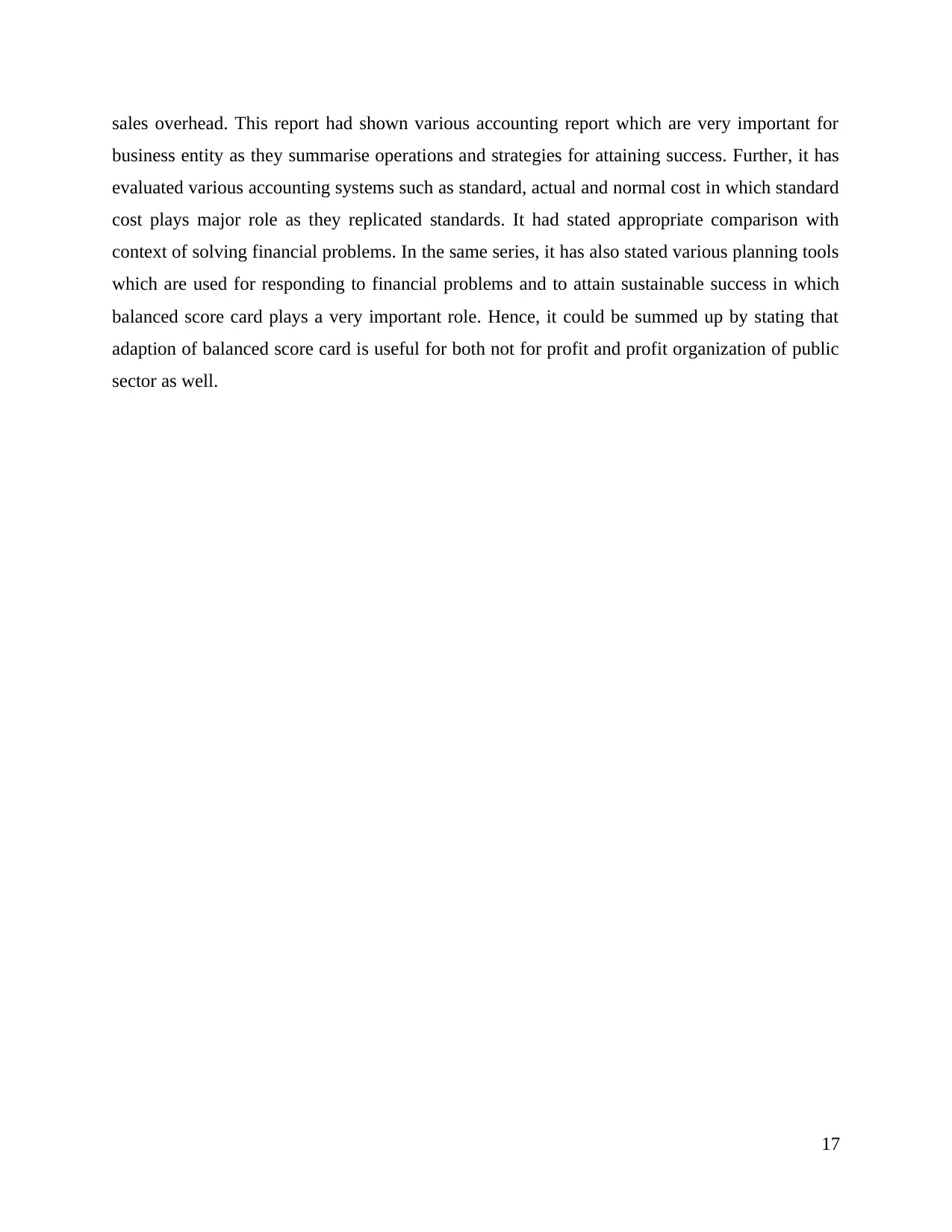
business entity as they summarise operations and strategies for attaining success. Further, it has
evaluated various accounting systems such as standard, actual and normal cost in which standard
cost plays major role as they replicated standards. It had stated appropriate comparison with
context of solving financial problems. In the same series, it has also stated various planning tools
which are used for responding to financial problems and to attain sustainable success in which
balanced score card plays a very important role. Hence, it could be summed up by stating that
adaption of balanced score card is useful for both not for profit and profit organization of public
sector as well.
17
Paraphrase This Document
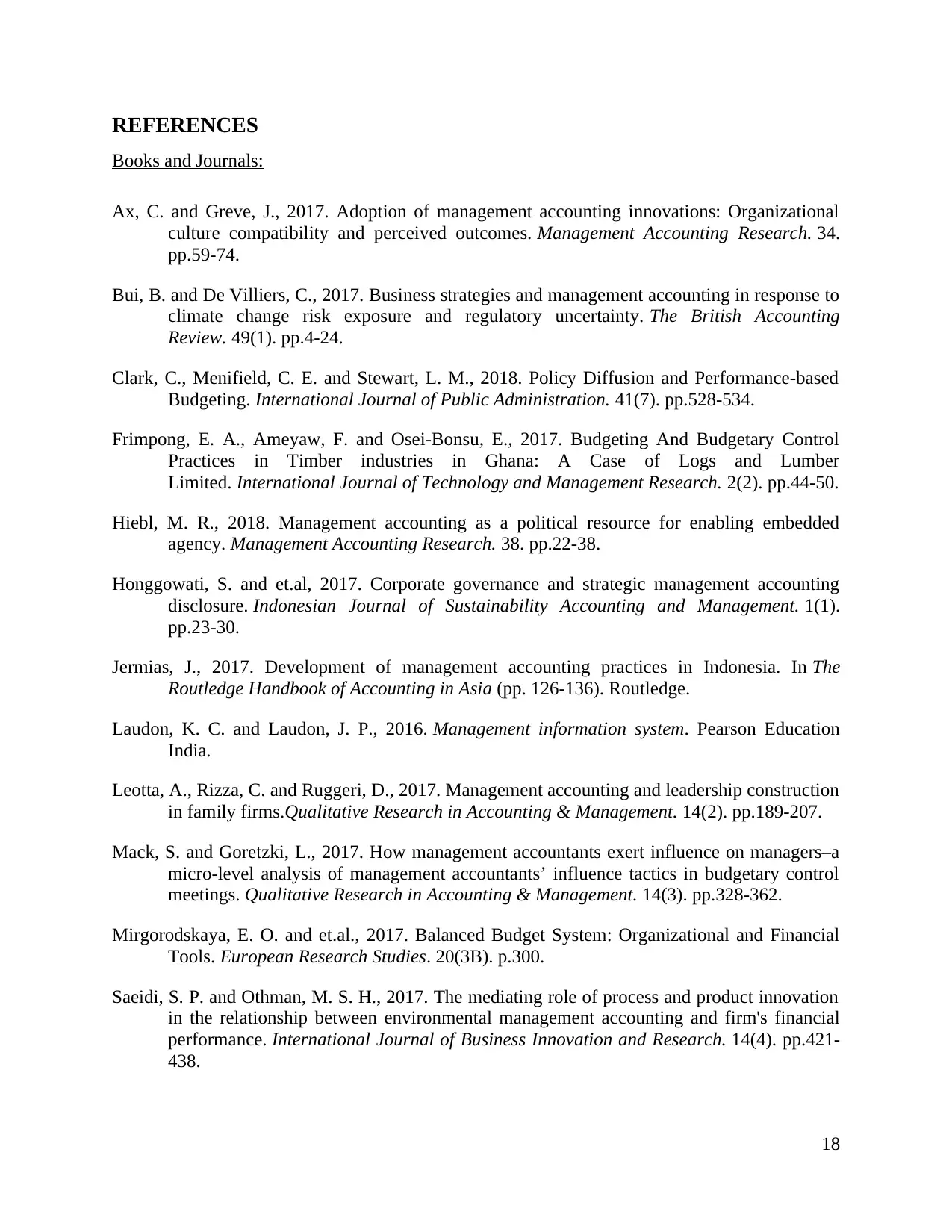
Books and Journals:
Ax, C. and Greve, J., 2017. Adoption of management accounting innovations: Organizational
culture compatibility and perceived outcomes. Management Accounting Research. 34.
pp.59-74.
Bui, B. and De Villiers, C., 2017. Business strategies and management accounting in response to
climate change risk exposure and regulatory uncertainty. The British Accounting
Review. 49(1). pp.4-24.
Clark, C., Menifield, C. E. and Stewart, L. M., 2018. Policy Diffusion and Performance-based
Budgeting. International Journal of Public Administration. 41(7). pp.528-534.
Frimpong, E. A., Ameyaw, F. and Osei-Bonsu, E., 2017. Budgeting And Budgetary Control
Practices in Timber industries in Ghana: A Case of Logs and Lumber
Limited. International Journal of Technology and Management Research. 2(2). pp.44-50.
Hiebl, M. R., 2018. Management accounting as a political resource for enabling embedded
agency. Management Accounting Research. 38. pp.22-38.
Honggowati, S. and et.al, 2017. Corporate governance and strategic management accounting
disclosure. Indonesian Journal of Sustainability Accounting and Management. 1(1).
pp.23-30.
Jermias, J., 2017. Development of management accounting practices in Indonesia. In The
Routledge Handbook of Accounting in Asia (pp. 126-136). Routledge.
Laudon, K. C. and Laudon, J. P., 2016. Management information system. Pearson Education
India.
Leotta, A., Rizza, C. and Ruggeri, D., 2017. Management accounting and leadership construction
in family firms.Qualitative Research in Accounting & Management. 14(2). pp.189-207.
Mack, S. and Goretzki, L., 2017. How management accountants exert influence on managers–a
micro-level analysis of management accountants’ influence tactics in budgetary control
meetings. Qualitative Research in Accounting & Management. 14(3). pp.328-362.
Mirgorodskaya, E. O. and et.al., 2017. Balanced Budget System: Organizational and Financial
Tools. European Research Studies. 20(3B). p.300.
Saeidi, S. P. and Othman, M. S. H., 2017. The mediating role of process and product innovation
in the relationship between environmental management accounting and firm's financial
performance. International Journal of Business Innovation and Research. 14(4). pp.421-
438.
18
Related Documents
Your All-in-One AI-Powered Toolkit for Academic Success.
+13062052269
info@desklib.com
Available 24*7 on WhatsApp / Email
![[object Object]](/_next/static/media/star-bottom.7253800d.svg)
© 2024 | Zucol Services PVT LTD | All rights reserved.





